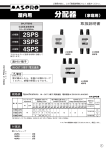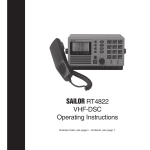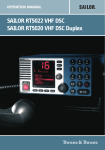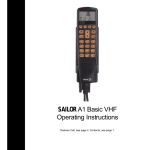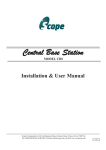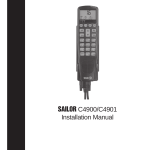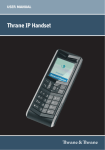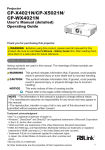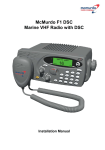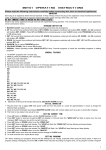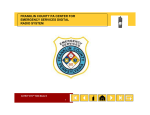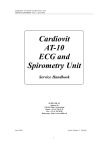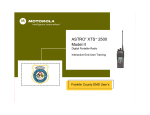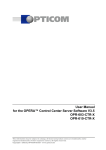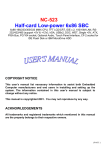Download User Manual - Polaris Electronics A/S
Transcript
SAILOR A1 VHF-DSC C4951WP Operating / Installation Instructions Distress Call, see page ii. Contents, see page 1. Introduction For more than half a century, SAILOR has been synonymous with state-of-the-art high-quality maritime communications equipment known for sturdiness, ease of operation and compact design. SAILOR is a world leader in the technologically advanced field of maritime communications. A wide range of products from GMDSS equipment and satellite communications equipment to simple VHF radios is ensuring the safety at sea and the daily communications around the world. The SAILOR A1 Basic and A1 DSC are part of the SAILOR System 4000. This is a full range of maritime communications equipment developed to increase safety and ease communications for all kinds of vessels: leisure boats, fishing vessels, cargo ships, and cruise liners. The C4951WP control unit for SAILOR A1 VHF is designed for cockpit installation. The C4591WP has been developed to meet the harsh environment at sea and is waterproof according to IP67. As our central concern is fast and professional service, we have introduced the SAILOR Certified Service Centre (CSC) concept. Thus, we are able to service your SAILOR VHF equipment in the best way possible in more than 90 countries all over the world. Abbreviations used in this manual ADDR ATIS BI CU DSC DUP DW GMDSS GPS LF MEM MMSI MSG PTT RX SQ STN TEL TX UTC Address Automatic Transfer Identification System Channel mode when sailing on European rivers (see page 00) Control Unit Digital Selective Calling Duplex Dual Watch Global Maritime Distress and Safety System Global Positioning System Low Frequency Memory Maritime Mobile Service Identification Message Push Receive/r Squelch Station Telephony Transmit/ter Coordinated Universal Time Please note Any responsibility or liability for loss or damage in connection with the use of this product and the accompanying documentation is disclaimed. The information in this manual is furnished for informational use only, is subject to change without notice, may contain errors or inaccuracies, and represents no commitment whatsoever. This agreement is governed by the laws of Denmark. Doc. No.: B4951GB0 ii Issue: D/0330 QUICK DSC DISTRESS CALL MAYDAY PROCEDURE (only for emergency use) 1. Press 16 to enter VHF mode on channel 16. 1. If necessary, switch on by pressing the ON key. 2. Lift handset off its rest. 3. Lift up lid covering the orange DISTRESS key and press for 5 seconds. The TX and Alarm indicator lights will flash. Release after 5 seconds and wait for answer. Unless stopped manually – by pressing the Cancel key or switching the unit off – the distress call is automatically transmitted every four minutes or so until acknowledgment is received. 4. To view the call, press RX Log followed by Select 2. Holding handset, press the PTT (Press To Talk) key and say: “MAYDAY” “This is” - the 9-digit identity and the call sign or other identification of the ship, - The ship’s position, - The nature of distress and assistance wanted, - any other information which might facilitate the rescue. “OVER.” Release the PTT key and listen for a answer. Please note that you can only transmit and be heard when pressing the PTT key and you can only receive when it is released. 0203 iii Your handset at a glance 15 16 17 18 19 20 1 2 3 4 5 6 7 8 9 10 11 12 14 1. Display 10. Channel selection key. 2. Indicator lamps. TX (lit when transmitting). 1W (lit when transmitting at 1 watt). US (lit when using American channels – see page 17). Alarm (lit when sending a distress call). 11. Intercom key. 3. Tel/DSC. Toggles between DSC and normal telephone mode. 13. Function key. 4. RX/Log. Launches a menu for accessing information on calls received. 14. Shift key. 13 12. Quick-select key for channel 16. 15. Microphone. 5. TX Call. Press to setup DSC call. 16. Earpiece. 6. Send Call. Press to transmit. 17. PTT (Press To Talk) key. 7. On/Off. Please also note that the unit should normally be left switched On. When switched Off, some information – such as data input on the vessel’s position – is lost. 18. DISTRESS key. 19. Loudspeaker. 8. Volume controls: increases volume, reduces volume. These up and down arrows are also used to navigate through menu options. 20. Call (lit when DSC call being received). 9. Squelch key. This is used to control the background noise present on calls. iv 0203 Contents - Operator Introduction ................................................................ ii Abbreviations used in this manual .......................... ii QUICK DSC DISTRESS CALL .................................. iii (only for emergency use) MAYDAY PROCEDURE ............................................. iii 5 Your VHF DSC in detail ......................................... 5 5.1 5.2 5.3 5.4 5.5 5.6 5.7 5.8 Full VHF telephone operation ................................. Memory scan tables ................................................ Selecting a scan table ............................................. Scanning channels ................................................. Dual watch .............................................................. Locking the keyboard .............................................. Unlocking the keyboard .......................................... Intercom .................................................................. 5 5 5 5 6 6 6 6 Your handset at a glance .......................................... iv 6 DSC operation in detail ........................................ 7 1 Telephone display ................................................. 2 2 Main handset function keys ................................. 2 3 Your VHF DSC in brief .......................................... 2 3.1 3.2 3.3 3.4 3.5 3.6 3.7 3.8 3.9 3.10 3.11 Switching ON/OFF .................................................. Basic telephone operation ...................................... Listening for telephone calls ................................... Receiving a call on channel 16 ............................... Making a telephone call .......................................... Channel selection ................................................... Squelch control ....................................................... Adjusting the volume .............................................. Muting the loudspeaker .......................................... Setting the transmitter power .................................. Dimming the display ............................................... 2 2 2 2 2 3 3 3 3 3 3 4 Basic DSC operation ............................................ 4 4.1 4.2 4.3 4.4 4.5 Receiving a DSC Call ............................................. Transmitting a DSC call to a ship station ............... Transmitting a DSC call to a shore station ............. Transmitting a DSC call to a landline via shore station ........................................................... Entering your position into the system ................... 4 4 4 6.1 6.2 6.3 6.4 6.5 6.6 6.7 6.8 6.9 6.10 6.11 6.12 6.13 6.14 6.15 6.16 6.17 6.18 Receiving DSC calls ............................................... 7 Differentiating calls by the ringing tone .................. 7 RX Log menu .......................................................... 8 The RX Log menu tree ........................................... 8 TX Call menu ........................................................ 10 Setting up a call using the EXTENDED TX Call menu .............................................................. 10 TX Call menu tree .................................................. 11 Function menu ...................................................... 12 Description of function menu items ...................... 13 Function menu tree ............................................... 14 Setting up the directory ......................................... 15 Adding an item to the directory ............................. 15 Viewing/deleting a directory entry ........................ 15 Setting up the address book ................................. 15 Description of VHF system ................................... 15 International Channels .......................................... 16 US Channels ......................................................... 17 BI Channels .......................................................... 18 4 4 Contents - Installation 7 Installation – Control Unit .................................. 19 7.1 7.2 7.3 7.4 7.5 Mounting possibilities ............................................ Power supply ........................................................ Control unit connection – Leisure class D VHF ... Connecting the transceiver / Control Unit ............ Connecting the transceiver / splitter box / indoor and waterproof Control Unit .................................. 7.6 Control Unit connection – Commercial class A VHF ...................................... 7.7 Loudspeaker connection ....................................... 7.8 Connectors ............................................................ 7.9 Installing the Control Unit ..................................... 7.10 Linking an external speaker .................................. 19 19 19 19 19 19 19 20 21 21 8.3 8.4 8.5 How to check TX transmitter – handset TX AF circuits and VHF transmitter) ................................ 25 How to check VHF signal reception – VHF receiver and handset RX AF circuits) ........... 26 How to check the TX/RX DSC mode .................... 26 9 Installation – Transceiver Unit ........................... 27 9.1 9.2 9.3 9.4 9.5 9.6 9.7 Mounting possibilities / Interface connections ....... Power Supply ........................................................ Aerial ..................................................................... Options Connection Box ....................................... Cable length .......................................................... Electrical connections ........................................... Compass safety distance ...................................... 27 27 27 28 29 29 29 8 System function checks ..................................... 22 8.1 8.2 0238 How to check system priorities – system control and SPARC-bus data interface circuits ................ 22 How to check intercom – handset TX AF circuits and handset audio amplifier circuits ..................... 23 10 Technical specification ....................................... 30 11 Drilling plan - Control Unit ................................. 31 1 Operation 1 Telephone display Normal display 3 Your VHF DSC in brief 3.1 Switching On/Off Press the key on the keyboard to switch On. To switch Off, press and hold for 2 seconds. 3.2 Basic telephone operation Press Tel DSC or 16 to activate the VHF telephone functions. 3.3 Listening for telephone calls According to international rules, all ships must continuously monitor channel 16: that includes yours. 1. Select channel 16 by pressing 16: Scanning display 2. Set the squelch level using the up and down arrows. If noise is present, press the up arrow until the hiss disappears. If no noise is present, press down arrow until hiss is heard, followed by one press of the up arrow. To listen for calls on other channels, either select the channel number or use the scanning facility. 3.4 Receiving a call on channel 16 When you hear your call name in the loudspeaker: 1. Lift the handset. 2. Press the PTT key. 3. Repeat the name of the station calling you and say “This is [your ship’s name].” 2 Main handset function keys On/Off 4. Suggest a channel other than 16 by saying “Channel [suggested number]”. 5. Say “Over” and release the PTT key to allow your caller to accept the suggested new channel. Switches the handset on or off. Tel/DSC Changes operation mode of handset. Toggles between DSC and TELEPHONE mode. RX log 6. Switch to the new channel – for example, channel 71 – and begin your conversation. Only press PTT when you are talking. If you are on a simplex channel (in other words, a channel that can carry just one transmission at a time), always say “Over” just before releasing. With duplex channels, the conversation can be two-way as with a normal land telephone call. Launches DSC menu to read DSC messages. TX Call Launches DSC menu to set up DSC calls for transmission. 3.5 Send Call 1. If not already in telephone mode, switch to it by pressing Tel/DSC or 16. Transmits the waiting DSC call. Cancel Cancels any DSC call that has started. Also cancels a DISTRESS or DISTRESS Repeat call. 16 Selects Telephone mode and switches to channel 16. Func Launches the function menu to set up the handset and system. If the function menu is already active, it switches to VHF telephone mode. After 5 minutes of inactivity, the handset automatically defaults to telephone mode. 2 Making a telephone call 2. Select channel 16 (by pressing 16) or other agreed channel. 3. Lift the handset. 4. Press the PTT key and make your call. First, say the name of the station you are calling three times. Then say “This is [your ship’s name”], again three times. Finally, say “Over”. 5. Release the PTT key to listen. 6. When answered, agree upon a channel, switch to that channel – for example, channel 6 – and begin your conversation. Only press PTT when you are talking. If on a simplex channel (in other words, a channel that can carry just one transmission at a time), always say “Over” just before releasing. 0238 Operation 3.6 Channel selection There are three ways to select a channel. First, by using the numeric keys. Second, by using the up or down arrows to move to a higher or lower number. And third (only for channel 16), by pressing 16. 3.6.1 Channel selection by numeric keys Press the numeric keys in sequence until the desired channel number is shown on the display: If available in your VHF system, a private channel can be selected by pushing the keys Shift and P before the numeric keys. The display then shows the letter P in front of the channel number. 3.6.2 If the loudspeaker is active, its setting is always shown on the display. Only when the handset is off its rest and the speaker is not set to be active is the volume level of the earpiece shown. When setting any level using the up or down arrows, holding the key down for more than 1 second will progress automatically until the limit is reached. Channel selection by up and down arrows First, press CH to display the current channel. Then use the up or down arrow to locate the channel you require. Finally, press CH again to exit the selection process. 3.9 Muting the loudspeaker If the loudspeaker is active, pressing PTT automatically mutes it, and releasing PTT reactivates it. To mute the loudspeaker without pressing PTT, press Shift and the 8 key (which also carries a speaker symbol). To reactivate the speaker, press Shift and 8 again. When the loudspeaker is muted, the display includes the appropriate icon. 3.10 Setting the transmitter power 3.6.3 Channel selection by quick select key 16 Pressing 16 switches to channel 16 at any time. 3.7 Squelch control The squelch setting is for suppressing background hiss during a call. Never use a higher squelch setting than is necessary. 3.7.1 Setting the squelch level manually First, press SQ to display the current squelch setting (below SQ on the display). Then use the up or down arrow to adjust. Finally, press SQ again to exit the selection process. If you press the up or down arrow for more than 4 seconds, the squelch level goes up or down automatically. 3.7.2 The transmitter power is either 25W (the default) or 1W: there are no intermediate settings. To change the TX power level, press Shift, Power: when the power is 1W, the indicator light will register this. Please note that some channels are programmed to operate only at low power, i.e. 1W. 3.11 Dimming the display The handset features a display backlight, a keyboard backlight and lights for the five indicators (CALL placed on handset, TX, 1W, US or BI, and ALARM). The brightness of all of these can be adjusted in four levels from 3 down to 0. The default setting is 3. To reduce the level, press Shift and then hold down the 7 key (which also says DIM). The level is indicated in the display and reduces every second. Subsequently, pressing any key will return the brightness to level 3. Setting the squelch level automatically Your VHF DSC can automatically optimise the squelch level. To do this, press Shift, SQ. 3.8 Adjusting the volume The volume can be adjusted by pressing the up or down arrow from 00 (muted) to 15 (loudest). Once the unit is switched OFF and back ON, the volume will revert to the default setting described below. The Volume has a default setting for both the loadspeaker and the earpiece which can be independently adjusted from 00 (muted) to 15 (loudest). To adjust the loudspeaker: 1. Press Shift, Func. 2. Press the up or down arrow twice to display GENERAL. 3. Press right arrow to display ILLUMINE. 4. Press up arrow to display SOUND. 5. Press right arrow to display EARPIECE. 6. Press up arrow to display LOUDSPEAKER. 7. Press right arrow to display NORM. 8. Now use the up or down arrow to increase or reduce the setting. 9. Once you are satisfied you have keyed in the required setting, press Shift, Func to exit. 0238 3 Operation 4 Basic DSC operation When switched on, your VHF set automatically monitors channel 70 for incoming DSC calls. 4.4 Transmitting a DSC call to a landline via shore station To set up and transmit a public DSC call via a shore station: 1. Press TX Call. 4.1 Receiving a DSC call When a DSC call is received, the handset will let you know what kind of DSC call it is. Immediately, the handset will display the message dSC RECEIVED, the call indicator lamp will flash, and the loudspeaker will announce the call. 1. If the call includes a proposal for switching to a particular VHF working channel, the unit will toggle between two displays. 2. If you now lift the handset off its rest, a DSC acknowledgment call is automatically transmitted, accepting the proposal and switching both the caller and your handset to the working channel. 3. You can now begin the call in normal telephone mode. 2. Press the up arrow twice to display SHORE STN. 3. Press the right arrow to display STN 00 *. 4. Key in the nine-digit MMSI number of the shore station you wish to call, using the numeric keys: 5. Once you are satisfied you have keyed in the correct number, press right arrow again. 6. Press up arrow, followed by right arrow. 7. Now key in the phone number you wish to call, using the numeric keys: 8. Once you are satisfied you have keyed in the correct number, press right arrow twice. 4.2 Transmitting a DSC call to a ship station To set up and transmit a DSC call and propose a working channel to a ship station: 9. Now press Send Call to transmit. 10. Once the call has been sent, the display will indicate that it is waiting for an acknowledgment: 1. Press TX Call. 2. Press right arrow to display STN *. 3. Key in the nine-digit MMSI number of the ship station you wish to call, using the numeric keys: 4. Once you are satisfied you have keyed in the correct number, press right arrow again to display SEND CALL. 5. Now press Send Call to transmit. 6. Once the call has been sent, the display will indicate that it is waiting for an acknowledgment: 4.5 Entering your position into the system If your VHF DSC is not connected to an external GPS system – which continuously updates your position (please refer to the installation manual)– you may enter the details as follows. Although it appears a lengthy procedure, it does not take long and well worth doing at regular intervals so that, in an emergency, your most recent position will be included in your DISTRESS call. To input the position of your vessel: 1. Press Shift Func 2. Press up arrow to display DSC 4.3 Transmitting a DSC call to a shore station 3. Press right arrow twice to display SELF ID 4. Press up arrow to display POSITION To set up and transmit a DSC call to a shore station: 5. Press right arrow to display POS VIEW 1. Press TX Call. 6. Press down arrow to display POSUPDATE 2. Press the up arrow twice to display SHORE STN. 7. Press right arrow to display POSITION 3. Press the right arrow to display STN 00 *. 4. Key in the nine-digit MMSI number of the shore station you wish to call, using the numeric keys: 5. Once you are satisfied you have keyed in the correct number, press right arrow again. 6. Now press Send Call to transmit. 7. Once the call has been sent, the display will indicate that it is waiting for an acknowledgment: 8. To enter the first part of your position, use the up or down arrow to select S or N followed by right arrow and then the relevant numeric keys. When complete, the word SELECT will appear in the top right of the display. 9. Press right arrow. 10. To enter the second part of your position, use the up or down arrow to select E or W followed by right arrow and then the relevant numeric keys. When the position data is complete, the word SELECT will appear in the top right of the display. 11. Press right arrow four times to store. 12. Check the stored information by pressing Tel/DSC twice. The display will now toggle the various details stored. 4 0238 Operation 5 YOUR VHF DSC IN DETAIL 5.1 Full VHF telephone operation 5.1.1 Setting channel mode Some VHF radios offer a choice between two sets of channels, called ‘channel modes’. If your unit features two modes, you can either switch between international and US channels or between international and BI channels. International mode is used when sailing on any sea in the world, except in US waters. US mode is used when sailing in US waters. BI mode is used when sailing on the rivers of Europe. 5.4 Scanning channels 5.4.1 To start scanning To start scanning, press Shift, Scan. From left to right, the lower part of the display shows the number of the scan Table, its name (if it has one), and its priority channel. If the Table has not been programmed with any channels, the display will show the message MEM EMPTY: 5.4.2 To stop scanning There are four ways to stop scanning. 5.1.2 Choosing international or US channel mode If your handset offers the choice, you can switch between international and US mode by pressing Shift CH: When US mode is selected, the yellow US indicator lamp is lit. Otherwise, the radio is in international mode. 0203 5.1.3 Choosing international or BI channel mode If your handset offers the choice, you can switch between international and BI mode by pressing Shift CH: When BI mode is selected, the yellow BI indicator lamp is lit. Otherwise, the radio is in international mode. When BI mode is selected, ATIS (Automatic Transfer Identification System) is automatically activated. 5.1.4 Transmitting at 25W power (for US channels 13 and 67 only) As described on page 3 under ‘Setting the transmitter power’, the handset can transmit at 1W or at 25W. However, with handsets programmed with US channels, some of the channels are restricted to 1W transmission and the TX power level cannot be changed to 25W as described. 1. By pressing Shift and Scan. The system then resumes normal VHF operation on the channel selected before scanning began. 2. By pressing 16. The system then resumes normal VHF operation on channel 16. 3. By lifting the handset off its rest. The system then resumes normal VHF operation on the channel selected before scanning began. 4. By pressing PTT. If no signal has been detected on any channel, the system resumes normal VHF operation on the channel selected before scanning began. If a signal has been detected on one or more channels, the system resumes normal VHF operation on the last channel where a signal was detected. When a signal is detected during scanning, the display changes to show the channel number and volume. With priority scanning, channel 16 is scanned once for every channel scanned in the Table. Channel 16 cannot be deleted or excluded from this process. 5.4.3 Adding a channel to a scan table To add a channel to a scan Table, first select the Table (see above) and check the display. Now select the channel – again check in the display – and press Shift, Store. For example, to add channel 6 to scan Table 1: 1. Press Shift, Mem, 1 to select Table 1. 5.2 Memory scan tables Your VHF DSC has eight independent memory Tables – 0 to 7 – for storing channels for scanning sessions. Each Table may contain any of the channels available in the system. To help distinguish between them, you can attach a name up to seven characters long to each Table number. To do this, enter the function menu by pressing Shift and Func (see page 12). The scan Table number is shown in the left corner of the handset display beneath MEM. Three of the Tables – 5, 6 and 7 – are pre-programmed and the contents cannot be altered in any way. In Table 5, the safety and security channels are 6 and 13, and the priority channel is 16. Table 6 contains the channels for ship-to-ship communication, apart from 6 and 13. And Table 7 contains all the channels available to the system. 5.3 Selecting a scan table To select a scan Table, press Shift, Mem followed by the number of the Table. For example, to select Table 0: 2. Now press 6 to select channel 6. 3. Finally, press Shift, Store. The display shows the message STORES CHANNEL for 2 seconds. 5.4.4 Deleting a channel from a scan table To delete a channel from a scan Table, first select the Table (see above) and check the display. Now select the channel – again check in the display – and press Shift, Delete. For example, to delete channel 6 from scan Table 1: 1. Press Shift, Mem, 1 to select Table 1. 2. Now press 6 to select channel 6. 3. Finally, press Shift, Delete. The display shows the message DELETE CHANNEL for 1 second. The display now shows the next channel in the Table. If there are no more channels in the Table and deletion is attempted, the display registers MEM EMPTY. 1. Press Shift followed by MEM. The handset shows the message SEL for select and the MEM symbol flashes. At the same time, the lower part of the display gives the Scan Table number and name (if it has one). 1. Press 0 The display now shows the new Table number, 0. 0203 5 Operation 5.4.5 Viewing contents of a scan table There are two ways of checking what channels are in a particular scan Table. While the key is pressed, the display will cycle through the channels of the chosen scan Table. 1. Press Shift and then hold down Scan. The display will keep cycling through the channels – one every second – from low to high and repeating as long as Scan is pressed. OR 2. Press Shift and then hold down Mem. The display will keep cycling through the channels – one every second – from low to high and repeating as long as Mem is pressed. 5.8 Intercom If your system has more than one control unit, you can use them for intercom, as follows: 5.8.1 Initiating an intercom call from the handset to another control unit To call another control unit: 1. Press Shift and Inter-C. The display shows SELECT NO asking you to type in the location number to be called. 2. Press a numeric key – for example 2 – to select the location you are calling. 5.5 Dual watch To start a dual watch with priority channel 16 and another channel, press Shift followed by the number of the second channel. For example, to start a dual watch with channels 16 and 6, press: Shift followed by 6. 3. If the location is not available, the display registers IC2 NOT AVAIL and does not dial the number. If it is available, the display shows IC2 CALLING and a ringing tone can be heard in the loudspeaker/earpiece. IC2 indicates that location 2 has been dialled. The lower part of the display now toggles between CALLING and the name of the unit called. During the next 30 seconds, you may lift the handset and speak into the microphone. The person receiving the call will then hear you via the loudspeaker without lifting his handset. In this way, the VHF system can be used as a sort of paging system. When a dual watch is in progress, the letters DW appear in the top left of the display and the priority channel is shown in the bottom right corner. 4. If the handset is lifted within the first 30 seconds, intercom is established. If no one answers your call, the handset automatically rings off and reverts to normal VHF operation. 5.5.2 5.8.2 With your VHF DSC, you can monitor two channels at the same time – a priority channel and your selected channel. 5.5.1 Starting a dual watch Stopping a dual watch A dual watch can be ended in three ways. 1. By pressing Shift, DW. 2. By pressing PTT. The system then resumes normal VHF operation on channel 6 and starts transmitting. 3. By pressing 16. The system then resumes normal VHF operation on channel 16. 5.6 Locking the keyboard The keyboard can be locked to avoid unintentional channel changes during a telephone call. When the keyboard is locked, the only functions that can be controlled are: 1. The volume. 2. The squelch level. 3. Channel selection using CH followed by the up or down arrow. What you cannot do with the keyboard locked is change channel using the numeric keypad. To lock the keyboard, press Shift once and then again, this time holding down for 1 second. The key symbol appears on the left of the display to show the keyboard is locked. Receiving an intercom call from another control unit If someone tries to set up an intercom to your handset: 1. The loudspeaker will broadcast a ringing tone and the display will toggle between CALLING and the name of the caller. The display will also show the location number of the caller – for example IC3 for location 3. 2. To answer, simply lift your handset. Connection between the two control units is now established. To communicate, simply press PTT and speak into the microphone. During an intercom call, you can adjust various features from the handset: 1. Adjust volume. 2. Mute/activate the loudspeaker. 3. Adjust squelch. 4. Adjust backlight level. 5.8.3 Terminating an intercom call The intercom connection can be ended by either of the control units, by: 1. Replacing the handset. VHF mode is resumed. 2. Pressing Shift and Inter-C. VHF mode is resumed. 5.7 Unlocking the keyboard 3. Pressing 16. VHF mode is resumed on channel 16. The keyboard can be unlocked in two ways: 1. By pressing Shift twice. 2. By pressing 16 for 1 second. This unlocks the keyboard and switches the unit to channel 16. 6 0238 Operation 6 DSC operation in detail 6.1 Receiving DSC calls When you receive a DSC call, the handset will ring (see next section). At the same time, the Call indicator lamp will light and, if it is a DISTRESS call, the Alarm indicator lamp will also light. In addition, one of the following will apply. 1. If the handset is on its rest in VHF mode If the handset is in VHF mode, it automatically switches to DSC mode. The display toggles with the second screen carrying limited information on the call. 2. If the handset is on its rest in DSC mode If the handset is in DSC mode or with its Function menu active, it continues as normal. 3. If the handset is off its rest in VHF mode If the handset is in VHF mode, it continues in VHF mode. Press Tel/DSC to see the display carrying limited information on the call as in 1. 4. If the handset is off its rest in DSC mode If the handset is in DSC mode or with its Function menu active, it continues as normal. In every case, to view the complete DSC message, press RX/Log and use the right arrow to step through the information. 6.2 Differentiating calls by the ringing tone Your VHF DSC rings in various ways according to the nature of the call, as the following diagram shows. 30 sec. Restarts after 30 sec. TONE SIGNAL DISTRESS CALL DISTRESS & URGENCY 1 sec. 7 sec. VHF CONNECT 3 sec. ALL SHIP SAFETY CALLS OTHER DSC CALLS 35294 The sequence of each of these repeats every 30 seconds or until the DSC call is read or answered. If the handset is off its rest, it rings with a short tone every 30 seconds until the call has been read. 0238 7 Operation 6.3 RX Log menu The RX log menu enables you to read the entire contents of a DSC call. It can also be used to set up an acknowledgment response when requested by the incoming DSC call. To enter the menu, press RX log followed by the up arrow to cycle through the following three options: 1. LAST CALL Select LAST CALL (a) when you have received a DSC call and the handset is toggling call information, (b) to view all calls and/ or (c) to respond. 2. ALARM LOG Select ALARM LOG (a) to view a DSC DISTRESS call and (b) to view all DISTRESS or urgent calls. 3. CALL LOG Select CALL LOG to view DSC calls from the memory buffer of the VHF DSC modem. 6.4 The RX Log menu tree The RX LOG MENU is used for reading information on DSC calls received. In addition, if requested by a DSC caller, an acknowledgment call can be set up. The main menu entries are as follows: 1. LAST CALL. Enter this item when a DSC call has been received and the handset toggles information or when you wish to view all calls and/or answer back. 2. ALARM CALL. Enter this item to view DSC DISTRESS calls and all other DISTRESS or urgent calls. 3. CALL. Enter this item to view DSC calls from the VHF DSC safety or routine ordinary calls buffer. 8 0203 Last call | | Alarm log | | | | | Call log 0203 XXXX info> XXXX info> tcmd info Timeinfo Rx time> 2 TCMD> Type info Calltype EOS> Date info EOS info Call type> Distr pos The call is too old if time elapsed since rx > 5 mins. W-ch XX> Rx date> Distr MMSI MMSI info FS info Lat info Approve No comply CAT info Distr time No reason Congestn Busy Queueindi Stnbarred No opr Opr unava Disabled Bad-vhfch Bad mode From> Utc XX XX If EOS = ackn bq If call already replied Call repl Call old At date If EOS = RQ and call too old If EOS = RQ and call QRW too old Category> Long info Date D info MMSI M info Distr D nat At time 6HQGFDOO View call 1 TCMD> Nat info Time info tcmd info Distr com Re-enter RX Com info Operation 9 Operation 6.5 TX Call menu The TX Call menu offers various ways of setting up DSC calls for transmission. The options range from totally manual setup using the extended calls entry and setting up each item of information involved, to almost automatic setup using the menu entries ADDR BOOK, SHIP STN, and SHORE STN. A DISTRESS call can be set up using the DISTRESS option in the TX Call menu. Alternatively, and more simply, pressing the orange DISTRESS key automatically transmits a DISTRESS call. To access the menu, first press TX Call. Pressing the up arrow then cycles through the following options. At each level, use the left and right arrows to select further options. SHIP STN Your input: MMSI number or a station stored in the station register, change of working channel if desired. Call setup: Automatic, individual routine including VHF working channel, requests acknowledgment. ADDR BOOK Your input: Name from the address book. Call setup: Automatic, depending on: Ship station: Shore station: Shore station including telephone number: SHORE STN Your input: MMSI number or pre-stored station from the station register, optional telephony number. 8. Press right arrow followed by up or down arrows to select SAFETY. (The other options here are ROUTINE, URGENCY and DISTRESS.) 9. Press right arrow to display 1 TELECMD. 10. Press right arrow and then use up or down arrows to select SIMPLEX. (The other options here are NO-INFO and NO COMPLY.) 11. Press right arrow to display ADD W-CH (add VHF working channel). 12. Press right arrow and then enter the number of the working channel for example “16”. 13. Press right arrow to display CALL ANSW. 14. Press right arrow followed by up or down arrows to select REQ ANSW. (The other option here is NO ANSWER.) 15. Press right arrow to display SEND CALL. 16. Finally, to transmit the call, press Send Call. Once the call has been transmitted, the handset waits for an acknowledgment that the call has been received. Please note that it is not always possible to backtrack if an incorrect choice is made in the menu selection. If this happens, cancel the procedure – for example by pressing 16 – and re-enter your selections. Call setup: Automatic, depending on: Telephone number included: No telephone number included: EXTENDED Your input: All information in call. Call setup: As specified by user. DISTRESS Your input: Nature of DISTRESS, position and time. If connected to GPS, time and position are automatically inserted. Call setup: A standard DISTRESS call. ALL SHIP Your input: Change of working channel if desired. Call setup: Automatic. All ships, safety, including VHF working channel. 6.6 Setting up a call using the EXTENDED TX Call menu The following example goes through the various stages of setting up a DSC call in the EXTENDED TX Call menu. 1. Press TX Call. 2. Press the up arrow three times to display EXTENDED. 3. Press right arrow to display CALL TYPE. 4. Press right arrow followed by up or down arrows to select INDV-STN. (The other option here is an ALL-STN call.) 5. Press right arrow to display MMSI. 6. Key in the nine-digit MMSI number of the ship or shore station you wish to call, using the numeric keys. When all nine digits have been entered, the word SELECT will appear at the top right of the display. 7. Press right arrow to display CATEGORY. 10 0238 Operation 6.7 Ship stn | | Addr book | | Shore stn | | Extended | | | | | | | | | | Distress | | | | | | | | | | | | All ship 0238 TX Call menu tree Stn XXX 6HQGFDOO View call name XXX 6HQGFDOO View call Stn XXX No Phone Add Phone No XXX Call type Indv-stn | | | | All-stn 6HQGFDOO View call MMSI XXXCategory Routine Safety Urgency Distress Category Safety Urgency Distress 1 Telecmd Simplex Add W-ch VHFCH XX No-info No W-ch No comply 1 Telecmd Simplex No-info If NO valid GPS input Nature of Fire Key pos> Known Lat edit Long edit Flooding Unknown Collision Grounding If valid GPS input Listing Sinking Adrift Undesignd Abandship Piracy Manoverb Add W-ch VHFCH XX No W-ch 6HQGFDOO View call Key time 6HQGFDOO View call Time edit Call answ Req answ 6HQGFDOO No answer View call W-ch XX 6HQGFDOO View call 11 Operation 6.8 Function menu The function menu enables you to set up and check the various functions of the handset. It also offers facilities to view and change the functions of the VHF transceiver and of the DSC modem. 6.8.1 To enter the function menu To set up or view items in the function menu, press Shift, Func. The display will read TELEPHONY. 6.8.2 To move around the function menu 1. Use the up and down arrows to locate the function – DSC, GENERAL or SERVICE. 2. Press the right arrow to select the function. 3. Press and hold the left arrow for 1 second to go back to function selection. 6.8.3 To edit items in the function menu 1. Use the up and down arrows (a) to toggle between Y (yes) and N (no) and (b) to change single numeric values up or down until the limit is reached. 2. Use the right arrow (a) to select an item and move to the next and (b) to move a step to the right in an item with more than one input. 3. Use the left arrow (a) to delete the character to the left of the cursor and (b) by holding for 1 second to go back to function selection. 4. Use the alphanumeric keys to enter data at the cursor position. 6.8.4 To exit the function menu If you have changed any setting while in the function menu, you must turn the handset off and then on again for the changes to take effect. You can exit in one of the following ways: 1. By pressing 16 to activate channel 16 in VHF mode. 2. By pressing Shift, Func to activate VHF mode on the last channel you used. 3. By pressing Tel DSC to activate VHF mode on the last channel you used. 4. By pressing RX Log to enter the DSC RX log menu. Example To activate a keyboard beep every time a key is pressed: 1. Enter the function menu by pressing Shift, Func. The display will read TELEPHONY. 2. Press the up or down arrow twice to display GENERAL. 3. Press the right arrow to display ILLUMIN. 4. Use the up or down arrow to locate SOUND. 5. Press the right arrow to display EARPIECE. 6. Press the up or down arrow twice to display KEYBOARD. 7. Press the right arrow to display KB.BLEEP N 8. Now use the up or down arrow to toggle the final Y (Yes) or N (No) to select. 9. Finally, press the right arrow to re-enter the function menu. To activate the new setting, turn the handset off and then back on again. 12 0203 Operation 6.9 Description of function menu items Path: Data: DSC\SETTINGS\ACKNOWLDG\AUTOACK Description: ‘Y’ enables automatic acknowledgment of "Y"/"N" incoming DSC calls GENERAL\ILLUMIN\INDICATOR\LEVL_0-3 0-3 GENERAL\ILLUMIN\DISPLAY\DB_L_0-3 0-9 GENERAL\ILLUMIN\DIMMER\D_LEVL 0-3 GENERAL\ILLUMIN\DIMMER\D_LEVL\DIMDIR 0-2 GENERAL\ILLUMIN\KEYB0ARD\SECS 0-20 GENERAL\ILLUMIN\KEYB0ARD\SECS\D_LEVL 0-3 GENERAL\SOUND\EARPIECE\NORM 0-15 GENERAL\SOUND\EARPIECE\NORM\ALARM 0-15 GENERAL\SOUND\LOUDSPEAK\NORM 0-15 GENERAL\SOUND\LOUDSPEAK\NORM\ALARM 0-15 GENERAL\SOUND\LOUDSPEAK\NORM\ALARM \EXT_SPK 0-3 GENERAL\SOUND\LOUDSPEAK\NORM\ALARM \EXT_SPK\HO_SPK 0-1 GENERAL\SOUND\KEYB0ARD\KBBEEP GENERAL\SOUND\SIDETONE\ST ATT SERVICE\DSC\SELF-ID\GRPEDIT SERVICE\TELEPHONY\CH+MODE\INPUTS 0203 Brightness levels of each indicator lamp Brightness levels of each backlight display lamp Brightness level when handset switched on Start direction of brightness level (see diagram on next page) Number of seconds light is on after a key has been pressed Brightness level when any key has been pressed, as long as above setting is at least 1 second Volume level in earpiece when handset is switched on Volume level in earpiece when DSC call or intercom received Volume of speaker when handset is switched on Volume of speaker when DSC call or intercom received Handset control of external speaker Speaker state when handset is off its rest. Default on = 1 or off = 0 "Y"/"N" Beep from keys when pressed Feedback level of microphone to earpiece. 0-3 Recommended setting = 1 0-9 Set up or change Group MMSI number Set up number of digits to be input when changing VHF channel. Y = 3 digits, N = 2 "Y"/"N" digits 13 Operation 6.10 Function menu tree Telephony | | | | Dsc | | | | | | | | | | | | | | | | | | | | | | | General | | | | | | | | | | | | | Service 14 Scanner Squelch Atis no Mem_no X Name XXX Mode X XXXXXXXXX Settings | | | | | | | | | | | | | Addr book | | Directory | | Testcalls Self-id | Position | | | | Acknowldg | Time date Pr-ch XX Pr_sc X MMSI-NU> XXXXXXXXX GrpMMSI XXXXXXXXX Posview X:XX’XX Pos auto X:XX’XX Pos mode Show X Posupdate X:XX’XX X:XXX’XX X:XXX’XX Utc time Utc XX:XX X:XXX’XX AT Utc HXX MXX XX XX XX Hour XX Date Mins XX Autoack X View Set Tzone XX Tzone XX Add name View del Name XXXX Mmsi XXX Name XXXX Mmsi XXX Add stn View del Name XXXX Mmsi XXX Name XXXX Mmsi XXX Localtime Utctime XX XX XX Secs XX Date Year XX Month XX Day XX Phone XXX Press sto Phone XXX If coast stn, phone number can be added for public call Press sto Int path Ext path Illumin | | | | Sound | | | | | Version Indicator Display Dimmer Keyboard Levl_0 X Levl_0 X D_levl X Secs XX Levl_1 X Levl_1 X D_dir X D_levl X Levl_2 X Levl_2 X Levl_3 X Levl_3 X Earpiece Loudspeak Keyboard Sidetone Norm XX Norm XX Beep X St att X Alarm XX Alarm XX Extspk X Ho spk X Handset Transceiv Software Software XXXXXX XXXXXX Serial no Serial no XXXXXXXX XXXXXXXX Code Bus setup DSC Telephony Handset Self-id CH_mode Loc no X GRP edit Input 3 x Name XXXX XXXXXXXXX 0203 Operation 6.11 Setting up the directory 6.14 Setting up the address book The directory, which is a subset of the DSC items in the function menu, can be programmed with the most frequently used stations. Both the number and name can be stored, if required. These can then later be retrieved for use in the TX Call menu. Entries can also be deleted if seldom used. The directory makes it easier and quicker to set up DSC calls using the SHIP or SHORE items in the DSC TX Call menu, the MMSI number being selected via identification name. The ADDR BOOK is a subset of the DSC items in the function menu and is very similar to the directory. However, with a coastal station entry, it does offer the extra facility of adding a public telephone number to the name and MMSI number. The directory makes it easier and quicker to set up DSC calls using the ADDR BOOK item in the DSC TX Call menu. To use the address book, follow the same procedure as for the directory but adding a public telephone number to the name. 6.12 Adding an item to the directory To add an entry to directory: 6.15 Description of VHF system 1. First enter the function menu by pressing Shift, Func. The display will read TELEPHONY. Up to seven control units may be connected to the VHF system, each with a unique location (1–7). However, only one of these – the master control unit – may control the transceiver. The various displays for different system priorities of the control units are described below. 2. Use the up or down arrow to locate DSC. 3. Press the right arrow to display DIRECTORY. 4. Press the right arrow followed by up or down arrows to locate ADD STN. The control unit designated location 1 has the highest priority in the VHF system and is able to become master of the system whenever required. When several control units are connected to the system, the main control unit has to be assigned location 1. 5. Press the right arrow and to display NAME 6. Now enter the name of the new item. This must be nine characters long, including spaces. If the name is shorter than this, add spaces (using the 0 key) until the total is nine. Use the alphanumeric keys to enter the name, cycling through the selection. For example, to type the O of POSEIDON, press the MNO key three times. Then move to the next character by pressing the right arrow. When all nine characters or spaces have been typed, the display will show SELECT in the top right. 7. Press the right arrow to select MMSI. 8. Now enter the nine-digit number of the item. 9. Press the right arrow to display PRESS STO. 10. Finally, store the name and number by pressing Shift, Store. 6.13 Viewing/deleting a directory entry To view/delete a directory entry: 1. First enter the function menu by pressing Shift, Func. The display will read TELEPHONY. 6.15.1 When the system is free If the handset is in VHF mode, the display will show: the selected channel If the handset is in DSC mode or the function menu is active, the display will show: dSC and SHIP STN. 6.15.2 When a control unit is master of the system When a control unit is master of the system, any other control units in VHF mode will show the following display to indicate that the transceiver is in use by another control unit: oCC and name and number of control unit in use. Any control units in DSC mode or with their the function menu active will display the normal menu screen. 6.15.3 How master priority is obtained Before a handset can operate the transceiver, it has to have priority in the system. This is achieved by simply lifting the handset off its rest. If the system is clear for the handset to transmit, the display does not change. 2. Use the up or down arrow to locate DSC. If another handset is already in use, the display will read: oCC and name and number of control unit in use. 3. Press the right arrow to display DIRECTORY. In that case, hang up and wait for the system to become free. 4. Press the right arrow followed by up or down arrows to locate VIEW DEL. 5. Pressing the right arrow will now display the name of the last station used. 6. Now either a) use the up and down arrows to cycle through the stored names or b) press the right arrow to view the MMSI number or c) press Shift, Del to delete the entry when the name is displayed. When an entry is deleted, the next one in the memory is displayed. If the directory is empty, the display reads MEM EMPTY. 0238 15 Operation 6.16 International Channels &KDQQHOV 1 2 3 4 5 6 7 8 9 10 11 12 13 14 15 16 17 18 19 20 21 22 23 24 25 26 27 28 7; 0+] 156,050 156,100 156,150 156,200 156,250 156,300 156,350 156,400 156,450 156,500 156,550 156,600 156,650 156,700 156,750 156,800 156,850 156,900 156,950 157,000 157,050 157,100 157,150 157,200 157,250 157,300 157,350 157,400 5; 6,03/(; '83/(; 0+] ,QWHUVKLS 3RUW 3RUW 3XEOLF 160,650 160,700 160,750 160,800 160,850 156,300 160,950 156,400 156,450 156,500 156,550 156,600 156,650 156,700 156,750 156,800 'LVWUHVVDQGFDOOLQJ 156,850 161,500 161,550 161,600 161,650 161,700 161,750 161,800 161,850 161,900 161,950 162,000 &KDQQHOV 60 61 62 63 64 65 66 67 68 69 70 71 72 73 74 75 76 77 78 79 80 81 82 83 84 85 86 87 88 7; 0+] 156,025 156,075 156,125 156,175 156,225 156,275 156,325 156,375 156,425 156,475 156,525 156,575 156,625 156,675 156,725 156,775 156,825 156,875 156,925 156,975 157,025 157,075 157,125 157,175 157,225 157,275 157,325 157,375 157,425 5; 6,03/(; '83/(; 0+] ,QWHUVKLS 3RUW 3RUW 3XEOLF 160,625 160,675 160,725 160,775 160,825 160,875 160,925 156,375 156,425 156,475 156,525 '6& '6& 156,575 156,625 156,675 156,725 156,775 / 156,825 / 156,875 161,525 161,575 161,625 161,675 161,725 161,775 161,825 161,875 161,925 157,375 157,425 Notes L) 1W TX power *) Channels 87 and 88 became simplex channels following the introduction of Automatic Identification channels AIS1 at 161.975MHz and AIS2 on 162.025MHz. NB The RX and TX frequencies can be read from the handset display by pressing and holding the CH key for more than 1 second. With a front-operated VHF radio, the frequencies can be displayed on a menu. 16 0203 Operation 6.17 US Channels &KDQQHOV 1 2 3 4 5 6 7 8 9 10 11 12 13 14 15 16 17 18 19 20 21 22 23 24 25 26 27 28 7; 5; 6,03/(; 0+] 0+] 156,050 156,050 '83/(; % 156,150 156,150 % 156,250 156,300 156,350 156,400 156,450 156,500 156,550 156,600 156,650 156,700 156,800 156,850 156,900 156,950 157,000 157,050 157,100 157,150 157,200 157,250 157,300 157,350 157,400 156,250 156,300 156,350 156,400 156,450 156,500 156,550 156,600 156,650 / 156,700 156,750 5; 156,800 'LVWUHVVDQGFDOOLQJ 156,850 156,900 156,950 157,000 157,050 157,100 157,150 161,800 161,850 161,900 161,950 162,000 &KDQQHOV 60 61 62 63 64 65 66 67 68 69 70 71 72 73 74 75 76 77 78 79 80 81 82 83 84 85 86 87 88 7; 0+] 5; 0+] 6,03/(; '83/(; &KDQQHOV % P1 P2 P3 P4 P5 P6 P7 P8 P9 P10 156,075 156,075 % 156,175 156,225 156,275 156,325 156,375 156,425 156,475 156,525 156,575 156,625 156,675 156,725 156,175 156,225 156,275 156,325 156,375 156,425 156,475 156,525 156,575 156,625 156,675 156,725 / :; WX1 WX2 WX3 WX4 WX5 WX6 WX7 WX8 WX9 WX10 5; 0+] 162,550 162,400 162,475 162,425 162,450 162,500 162,525 161,650 161,775 163,275 '6& % % 156,875 156,925 156,975 157,025 157,075 157,125 157,175 157,225 157,275 157,325 157,375 157,425 156,875 156,925 156,975 157,025 157,075 157,125 157,175 161,825 161,875 161,925 161,975 157,425 / Notes: L) B) !) RX) NB! 0203 1 W TX power. Pressing the 25W button in the US rest will make the unit transmit at 25W on channel 13 and 67, normally limited to 1W. Channels 2, 4, 60, 62, 75 and 76 cannot be selected in US mode. Channels 3, 21, 23, 61, 64, 81, 82 and 83 may be legally used in some circumstances but not by the general public in US waters. Only RX: transmissions are blocked. The RX and TX frequencies can be read from the handset display by pressing and holding the CH key for more than 1 second. With a front-operated VHF radio, the frequencies can be displayed on a menu. 17 Operation 6.18 BI Channels &KDQQHOV 1 2 3 4 5 6 7 8 9 10 11 12 13 14 15 16 17 18 19 20 21 22 23 24 25 26 27 28 7; 0+] 156,050 156,100 156,150 156,200 156,250 156,300 156,350 156,400 156,450 156,500 156,550 156,600 156,650 156,700 156,750 156,800 156,850 156,900 156,950 157,000 157,050 157,100 157,150 157,200 157,250 157,300 157,350 157,400 5; 6,03/(; '83/(; 0+] ,QWHUVKLS 3RUW 3RUW 3XEOLF 160,650 160,700 160,750 160,800 160,850 156,300 / 160,950 156,400 / 156,450 156,500 / / 156,550 / 156,600 / 156,650 / / 156,700 / 156,750 / / 156,800 'LVWUHVVDQGFDOOLQJ 156,850 / / 161,500 161,550 161,600 161,650 161,700 161,750 161,800 161,850 161,900 161,950 162,000 &KDQQHOV 60 61 62 63 64 65 66 67 68 69 70 71 72 73 74 75 76 77 78 79 80 81 82 83 84 85 86 87 88 7; 0+] 156,025 156,075 156,125 156,175 156,225 156,275 156,325 156,375 156,425 156,475 156,525 156,575 156,625 156,675 156,725 156,775 156,825 156,875 156,925 156,975 157,025 157,075 157,125 157,175 157,225 157,275 157,325 157,375 157,425 5; 6,03/(; '83/(; 0+] ,QWHUVKLS 3RUW 3RUW 3XEOLF 160,625 160,675 160,725 160,775 160,825 160,875 160,925 156,375 156,425 156,475 156,525 '6& '6& 156,575 / 156,625 / 156,675 156,725 / 156,775 % 156,825 % 156,875 / 161,525 161,575 161,625 161,675 161,725 161,775 161,825 161,875 161,925 157,375 157,425 Notes: B) Channels 75 and 76 cannot be selected in BI mode. L) 1W TX power on channels 6, 8, 10, 11, 12, 13, 14, 15, 17, 71, 72, 74 and 77. *) Channels 87 and 88 became simplex channels following the introduction of Automatic Identification channels AIS1 at 161.975MHz and AIS2 on 162.025MHz. NB The ATIS function is enabled on all channels. RX and TX frequencies can be read from the handset display by pressing and holding the CH key for more than 1 second. With a frontoperated VHF radio, the frequencies can be displayed on a menu. 18 0203 Installation - Control Unit 7 Installation – Control Unit 7.1 Mounting possibilities Mounting is carried out by first fixing the backplate, after which the Control Unit can simply be slid over and clicked into place. There is a template on page 31 to help you mount the unit. To avoid theft, the control unit can be removed when leaving the boat or during the off-season simply by pressing the spring and lifting it off the backplate 7.2 Control Unit connection – Commercial class A VHF Remote control units can be connected in two ways: 1. Directly between the transceiver and the control unit . 2. Via a SPARC-bus splitter box or WP SPARC-bus connection box. Both control units with or without DSC can be connected. Remote speakers may be connected to remote Control Units, to a splitter box , or via a WP SPARC-bus connection box. Power supply The Control Unit is supplied with +12V DC from the SPARC-bus interface. If there is a short circuit or fire, it is important that your VHF remain operational. We therefore recommend that the power cable be connected directly to the ship’s battery. 7.3 7.6 Not more than seven handsets can be simultaneously connected to the transceiver with DSC. Always connect the local Control unit to the transceiver. The DSC class of intelligent Control Unit is ‘D’ even if the radio is Class A. Indoor Control unit connection – Leisure class D VHF Outdoor TX 1W US Remote control units can be connected in two ways CALL ALARM Transceiver 12V DC Rx / Tx 1. Directly between the transceiver and the control unit . SPARC-BUS OPTION HANDSET PRINTER 2. Via a SPARC-bus splitter box or WP SPARC-bus connection box (optional, not included). Both control units with or without DSC can be connected. Remote speakers may be connected to remote Control Units via a splitter box , or a WP SPARC-bus connection box. Not more than four Control Units can be simultaneously connected to a transceiver without DSC and not more than seven with DSC. 7.4 Connecting the transceiver / Control Unit 56.114 Factory delivered 38051A 7.7 Loudspeaker connection When one or more control units are connected to the VHF system, two of them can be set up to use the transceiver’s two loudspeaker outputs to drive external speakers. To link a loudspeaker to a control unit: Indoor 1. Lift the handset. 2. Press Shift, Func to display TELEPHONY. Transceiver X1 3. Press down arrow twice to display GENERAL. 4. Press right arrow once to display ILLUMIN. 5. Press down arrow twice to display SOUND. 38050 6. Press right arrow once to display EARPIECE. 7. Press up arrow once to display LOUDSPEAK. 7.5 Connecting the transceiver / splitter box / indoor and waterproof Control Unit Indoor Outdoor TX 1W US CALL 9. Use up and down arrows to set external speaker to 1 or 2, as required. 10. Press right arrow to complete selection. If you make a mistake at any step, simply press 16 to return to the beginning. It is not possible to step backwards through the menu sequence. ALARM Transceiver X1 WP SPARC-Bus connection (Optional) 56.114 8. Press right arrow three times to display EXTSPK. Loudspeaker signals are available in the SPARC-bus cabling, and a loudspeaker can be connected to the system rest, in the SPARC-bus splitter box, or in the WP SPARC-bus connection box. Connect the loudspeaker cables to SPARC-bus signals (LS_1+ and LS1_!) or (LS_2+ and LS_2!) depending on which speaker selection is made by the control unit(s). Factory delivered 38052A 0310 19 Installation - Control Unit 7.8 Connectors SPARC-bus splitter box WP SPARC-bus connection box SPARC- 3 4 AF+ 4 5 AF- 5 6 -BAT 6 7 +12VDC 7 -BAT 8 2 SPARC+ 3 1 2 1 SUPPLY _ON +12VDC SPARC+ SPARC- RX_AF+ 9 RX_AF- 9 10 +12VDC 10 X2 AF+ 8 X3 X1 SUPPLY_ON AF- RX_AF+ RX_AF+12VDC 11 11 LS_1+ LS_1+ 12 13 -BAT LS_2+ 13 LS_1-BAT 14 14 12 LS_1- LS_2+ 15 15 LS_2- LS_2- Shield NC 37394 35349A SPARC-bus cable For systems with a supply voltage of +12V, the table below gives the maximum length of the SPARC-bus cable for the supply to a single control unit furthest away from the transceiver. The cable length depends on the number of supply wires and the wire thickness. For a +24V supply the maximum cable lengths listed may be doubled. 1XPEHU 6\VWHP VXSSO\ +12 Volt +12 Volt +12 Volt +12 Volt 56.114 1XPEHURI ZLUHVLQFDEOH 2x8 2x8 2x8 2x8 )URP 7R Transceiver Transceiver Transceiver Transceiver CU CU CU CU :LUH PP 0.25 0.50 0.75 0.14 1XPEHURIZLUHV 1XPEHURIZLUHV 0D[ %$7729'& 9'& OHQJWK 2 2 30 metres 2 2 60 metres 2 2 100 metres 3 2 5 metres The SPARC-bus cable length is limited by the output power delivered to an external speaker connected to the LS2 terminals. The speaker output power depends on cable length and cable thickness as in the table below :LUH>PP@ 0.14 0.25 0.25 0.50 0.50 0.75 0.75 /HQJWK>P@ 5 10 20 20 40 30 60 0D[3RZHU>:@ 3.4 3.2 2.0 3.2 2.0 3.2 2.0 56.114 35356 SPARC-bus/Option cable 5 metres 56.114 3LQQR pin 1 pin 2 pin 3 pin 4 pin 5 pin 6 pin 7 pin 8 pin 9 pin 10 pin 11 pin 12 pin 13 pin 14 pin 15 Shield 20 1DPH SUPPLY_ON SPARC+ SPARCAF+ AF-BAT_0VDC +12VDC RX_AF+ RX_AF+12VDC LS_1+ LS_1-BAT_0VDC LS_2+ LS_2- &RORXU 7ZLVWHGSDLU Red/White 7 Yellow 1 Yellow/White 1 Blue/White 2 Blue 2 Red and Orange 7/8 Orange/White 8 Green/White 3 Green 3 Black/White 6 Brown 4 Brown/White 4 Black 6 Purple 5 Purple/White 5 Shield SPARC-bus connections 7UDQVFHLYHU XQLW ; pin 1 pin 2 pin 3 pin 4 pin 5 pin 6 pin 7 pin 8 pin 9 pin 10 pin 11 pin 12 pin 13 pin 14 pin 15 1DPH 7ZLVWHG +DQGVHW SDLU +22. ;; SUPPLY_ON 1 SPARC+ 1 2 SPARC1 3 AF+ 2 4 AF2 5 -BAT_0VDC 6 +12VDC 7 RX_AF+ 3 8 RX_AF3 9 +12VDC 10 LS_1+ 4 11 LS_14 12 -BAT_0VDC 13 LS_2+ 5 14 LS_25 15 63$5&EXV FRQQHFWLRQER[ ;;; 1 2 3 4 5 6 7 8 9 10 11 12 13 14 15 0330 Installation - Control Unit 7.9 Installing the Control Unit 1. With the VHF system turned off, connect the control unit- to the system as described above. 2. Switch the VHF system on by pressing the ON/OFF button 3. The next step is to set up the control unit SPARC-bus location number and SPARC-bus handset name by the following steps. 4. Press Shift, Func to display TELEPHONY. 5. Press down arrow to display SERVICE. 6. Press right arrow. An asterisk will flash. 7. Key in your access code 9876 using the alphanumeric keys. To enter the first digit, press the appropriate key rapidly four times to display the digit. Then pause for two seconds until the asterisk moves to the right. Now enter the second digit by pressing four times in quick succession. Continue until all four digits have been entered. If you make a mistake, use the left arrow to move backwards and cancel. 8. Press right arrow three times, to display BUS SETUP, HANDSET and LOC NO in turn. 9. Use up or down arrow to change SPARC-bus location number. 10. Press right arrow. 11. Use the Func and Power keys to enter or change the name of the handset. 12. Press right arrow to move one character to the right or select the name already entered. 13. To finish setup, press Shift and Func. Alternatively, just press 16. 7.10 Linking an external speaker If an external speaker is to be linked to the handset, proceed as follows. 1. Lift the handset. 2. Press Shift, Func to display TELEPHONY. 3. Press down arrow twice to display GENERAL. 4. Press right arrow once to display ILLUMIN. 5. Press down arrow twice to display SOUND. 6. Press right arrow once to display EARPIECE. 7. Press up arrow once to display LOUDSPEAK. 8. Press right arrow three times to display EXTSPK. 9. Use up and down arrows to display 0 for no external speaker selected, 1 for external speaker 1, 2 for external speaker 2, or 3 for both external speakers. 10. Press right arrow to complete selection. If you make a mistake at any step, simply press 16 to return to the beginning. It is not possible to step backwards through the menu sequence. ATTENTION: When more control units are connected to the VHF system, they all have to be assigned different location numbers for the system to function correctly. The control unit at a ship’s central control should be assigned location number 1. Under the VHF system, the control unit with location number 1 has the highest priority in the system and so is able to control the system at any time. 0238 21 Installation - Control Unit 8 System function checks After a handset has been connected to the VHF system, go through the following test procedures to ensure the system is working properly. If the tests are successful, the VHF system is functioning correctly. Purpose: To test correct assembly of the system, ensuring SPARC-bus command communication between all system units – including system control priorities for the control units – and to check the telephony TX LF and RX LF routing. Test setup: Switch all control units on, with all handsets on their rests and each showing VHF display. 8.1 How to check system priorities – system control and SPARC-bus data interface circuits If only one control unit is connected, lift the handset and change the channel or push PTT once to ensure the handset is able to control the system. If more control units are connected, do the following: Test setup Result expected 1a Handset loc_1: VHF display. Handset (loc_1): Hook off. 16 MEM VOL SQ 0 08 01 Other control units: oCC display. oCC 1 “NAME” 1b Other control units in Hook off. Handset loc_1: VHF display. 16 MEM VOL SQ 0 08 01 Other control units: oCC display. oCC 1 “NAME” 2 All control units: Hook on. All control units: VHF display (system idle). 16 MEM VOL SQ 0 08 01 3a Handset (loc_2): Hook off. Handset loc_2: VHF display. 16 MEM VOL SQ 0 08 01 Other control units: oCC display. oCC 2 “NAME” 3b Handset (loc_1): Hook off. Handset loc_1 or loc_2: VHF display. 16 MEM VOL SQ 0 08 01 Other control units: oCC display. oCC 1 “NAME” 22 0203 Installation - Control Unit 3c Handset (loc_1): Hook on. Handset loc_2: VHF display. 16 MEM VOL SQ 0 08 01 Other control units: OCC display. oCC 2 “NAME” 3d Handset (loc_3): Hook off. Handset loc_2: VHF display. 16 MEM VOL SQ 0 08 01 Other control units: OCC display. oCC 2 “NAME” 3e Handset (loc_3): Hook on. Handset loc_2: VHF display. 16 MEM VOL SQ 0 08 01 Other control units: OCC display. oCC 2 “NAME” 3f Handset (loc_2): Hook on. All on hook. All control units: VHF display (system idle). 16 MEM VOL SQ 0 08 01 If the various control units do not behave as described, some of them may have been assigned the same location number. If so, check the location number setup in each unit. 8.2 How to check intercom – handset TX AF circuits and handset audio amplifier circuits If only one control unit is connected, ignore this test. If other control units are connected, proceed as follows. Test setup Result expected 1 Handset (loc_1): Inter-C dial display and dialling tone in the handset. Handset (loc_1): IC2 CALLING Handset (loc_2): Inter-C dial display and dialling tone in the handset. IC1 CALLING Other control units: VHF display. 2 Handset (loc_1): 16 Handset (loc_1): Inter-C dial display MEM VOL SQ 0 08 01 0238 23 Installation - Control Unit Hook off. and dialling tone in the handset. Handset (loc_2): Inter-C dial display and dialling tone in the handset. Other control units: VHF display. IC2 CALLING IC1 CALLING 16 MEM VOL SQ 0 08 01 3 Handset (loc_1): Press PTT and talk. Handset (loc_1): Inter-C dial display and dialling tone in the handset. IC2 CALLING Handset (loc_2): Voice output in speaker and dialling tone in the handset. IC1 CALLING Other control units: VHF display. 16 MEM VOL SQ 0 08 01 4 Handset (loc_2): Hook off. Handset (loc_1): Inter-C display. IC2 “NAME 2” Handset (loc_1): Inter-C display. Intercom in progress, talk both ways. Voice in both handset earpieces/speakers. IC1 “NAME 1” 16 Other control units: VHF display. MEM VOL SQ 0 08 01 5 Handset (loc_1): Hook on. Handset (loc_2): VHF display. 16 MEM VOL SQ 0 08 01 Other control units: oCC display. oCC 2 “NAME” 24 0238 Installation - Control Unit 6 Handset (loc_2): Hook on (all on hook) All control units: VHF display (sys idle). 16 MEM VOL SQ 0 08 01 8.3 How to check TX transmitter – handset TX AF circuits and VHF transmitter For this test, transmitter power level must be 25W (that is, the 1W indicator lamp will not be lit). If the VHF transmitter fails, the 1W indicator lamp will go on when the PTT button is pressed and/or the display will show the error message ANTN FAIL. In this event, check that the aerial and aerial cable are connected correctly. Test setup Result expected 1 Handset (loc_1): VHF display. Handset (loc_1): Hook off. 67 MEM VOL SQ 0 08 01 Other control units: oCC display. oCC 1 “NAME” 2 Handset (loc_1): Press PTT. Handset (loc_1): VHF display. TX indicator lamp is lit. 67 MEM VOL SQ 8 08 01 Other control units: oCC display. oCC 1 “NAME” 3 Handset (loc_1): Release PTT. Handset (loc_1): VHF display TX indicator lamp turns off. 67 MEM VOL SQ 0 08 01 Other control units: oCC display. oCC 1 “NAME” 4 Handset loc_(1): Hook on. All control units: VHF display (system idle). 67 MEM VOL SQ 0 08 01 0238 25 Installation - Control Unit 8.4 How to check VHF signal reception – VHF receiver and handset RX AF circuits Proceed as follows for each control unit. Test setup Result expected 1. There is static noise – a background hissing – from all the control unit speakers. If nothing can be heard, switch the speaker on and turn up the volume. All handsets on their rests (VHF display) with squelch thresholds set to zero. 67 MEM VOL SQ 0 08 01 8.5 How to check the TX/RX DSC mode To test the system’s DSC functionality, two test calls must be made – an INTernal test and an EXTernal test. Internal test In this test, the call is looped back internally, not via the transmitter or receiver. The test controls the DSC modem in the transceiver RX and TX internally. External test In this test, the call is transmitted and received via the aerials. The test also controls the transmitter and receiver circuits. 1. Lift the handset. 1. Lift the handset. 2. Press Shift, Func to display TELEPHONY. 2. Press Shift, Func to display TELEPHONY. 3. Press up arrow once to display DSC. 3. Press up arrow once to display DSC. 4. Press right arrow once to display SETTINGS. 4. Press right arrow once to display SETTINGS. 5. Press down arrow twice to display TESTCALLS. 5. Press down arrow twice to display TESTCALLS. 6. Press right arrow twice to display EXT PATH. 6. Press right arrow once to display INT PATH. 7. Press right arrow once to display SENDCALL. 7. Press right arrow once to display SENDCALL. 8. Press Send Call key. 8. Press Send Call key. 9. The display will rapidly show, in sequence, TX-CALL, TX-OK. 9. The display will rapidly show, in sequence, TX-CALL, TX-OK. 10. The call is announced by the DSC modem. Read the call info in RX-LOG. 26 10. The call is announced by the DSC modem. Read the call info in RX-LOG. 0238 Installation - Transceiver Unit 9 Installation – Transceiver Unit 9.1 Mounting possibilities / Interface connections The transceiver unit is available in both a one- and a two-aerial version. A one-aerial DSC transceiver can be converted into a two-aerial version (contact your dealer). The drawing below shows a two-aerial transceiver unit: NMEA interface for GPS SPARC-BUS 56.5 mm OPTION 14.5 mm 198 mm 242 mm SPARC-Bus interface for Control Unit OPTION SPARC-BUS Aerial for DSC channel 70 (only available on 2 aerial version) Rx/Tx Aerial for transmitting/ receiving VHF signals (for one aerial version DSC and distress calls will be received on Rx/Tx aerial) Power 222 mm 136 mm 100 mm 77.50 mm 4 x ø4 mm 38344 Weight: Transceiver Unit 1.3 kg WARNING: Only use original screws; otherwise you risk short-circuiting the battery ground to the ship ground. 9.2 Power Supply The standard power supply for the VHF unit is 12V DC. For 24V DC 10V AC, 127V AC, 220V AC or 237V AC supply external power supplies can be used. 24 24 Vo t lt 12 o Vo lt Vo t lt 12 o Vo lt 220 24 Vo to lt Vo lt + 12 V Ba olt tter y + 24 V Ba olt tter y + - 24 V Ba olt tter y 220 Vo lt 35344C Fuse The fuse is a standard 10A mini car fuse. There is a spare fuse in the power cable connector. 9.3 Aerial The transceiver without DSC requires one aerial. The transceiver with DSC is available in both a one- and a two-aerial version. All common 50W aerials covering the used frequency range with a reasonable standing wave ratio, max. 1.5, can be used. Aerials are connected to the set by means of a 50W coaxial cable with low loss, e.g. RG213U. For each cable, two PL259 plugs are used, one mounted at each cable end. 0203 27 Installation - Transceiver Unit 9.3.1 Placing the Aerial(s) Aerials should be mounted in a place that is as high and clear as possible - like the “primary aerials” in the illustration below. The horizontal distance to metal parts must be at least 1m. When using two aerials, the primary aerial must be placed at a higher level than the channel-70 aerial: 9.4 Options Connection Box Options connectors NMEA_OUTNMEA_IN+ NMEA_IN- 5 -BAT 6 8 FAN_ON 7 +12VDC X2 X1 NMEA_OUT+ 4 RX_1_SQ 9 CH_AUX_1 10 CH_AUX_2 12 RX_1_AF 11 1 1 2 2 3 3 DSC_ALARM_ON ;; 1 Optional Optional 4 5 6 7 8 9 10 11 12 13 14 15 3 2SWLRQER[ SDLU 2 13 14 15 7ZLVWHG 1DPH DSC_ALARM_ON NMEA_OUT+1 NMEA_OUT-1 NMEA_IN+ NMEA_IN-BAT_0VDC +12VDC FAN_ON RX_1_SQ CH_AUX_1 CH_AUX_1 RX_1_AF N.C. N.C. N.C. 1 7UDQVFHLYHUXQLW ; pin 1 pin 2 pin 3 pin 4 pin 5 pin 6 pin 7 pin 8 pin 9 pin 10 pin 11 pin 12 pin 13 pin 14 pin 15 35350 To connect a GPS to the VHF transceiver, connect the GPS signal lines to the options connector pin_4 (NMEA_IN+) and pin_5 (NMEA_IN-). X2 56.111 Alternatively the GPS can be connected directly to the transceiver by means of a 15-pole high density D-sub in the same pins as those mentioned above. Make sure to use the 15 to 15-pole adaptor between the transceiver and the 15-pole high density D-sub. The two partsare supplied with the radio. GPS H4992 Connection Box 35379B 28 0203 Installation - Transceiver Unit 9.5 Cable length The cable length specified below is the absolute maximum length. Power Cable 1XPEHU 56.112 6XSSO\ +12 volt +12 volt )URP BATTERY BATTERY 7R VHF DSC VHF DSC :LUHPP 2.5 5.0 0D[OHQJWK 1.5 metres 3 metres Note: The cable length from battery to power supply depends on the wire thickness, but the voltage at the cable end at the power supply should not be less than 18 volt. steel spring 3 2 1 10 3LQQR 1DPH &RORXU Pin 1 Pin 2 Pin 3 SUPPLY_ON +BAT -BAT Blue * Red Black Spare 10A fuse 35355A NB! Press and hold steel spring on power connector when disconnecting power cable from transceiver. Failure to do so may damage the connector. * NB! The blue wire is only to be used in connection with power supply. 9.6 Electrical connections Power connector Transceiver unit pin 1 pin 2 pin 3 9.7 Battery NC + - Power supply SUPPLY_ON +12V 0V Compass safety distance Unit Transceiver Unit Control Unit Handset 12V power supply 24V power supply 0203 Name SUPPLY_ON +Battery, +12VDC - Battery, 0VDC Standard 0.3 m 1.05 m 0.3 m 0.6 m 1.2 m Steering 0.3 m 0.7 m 0.2 m 0.3 m 0.7 m 29 Installation - Transceiver Unit 10 Technical specification Conforms to all relevant international requirements and resolutions as agreed by ETSI, IEC, ITU, and IMO as well as other national requirements. These specifications include ETS 300 162, ETS 300 338, IEC 945, IEC 1097-3 and IEC 1097-7. General Information Normal channels Opt. channels Channel spacing Frequency range Operating modes Modulation Frequency stability Aerial connectors Temperature range Supply voltage Supply range Supply current Transceiver dimen. Transceiver weight Receiver Sensitivity for: 12 dB SINAD AF rated power Output 1 Output 2 Distortion THD Signal/noise ratio AF response Spurious emission Spurious resp. att. Intermodulation att. Blocking Co-channel rejection Adj. ch. selectivity Transmitter RF output power Adj. ch. power Spurious radiation Cabinet radiation AF response Distortion Signal/noise ratio DSC Facilities: DSC operation DSC protocol Navigator interface Symbol error rate below 1*10-2 at Modulation Frequency error Residual DSC-mod. 30 All int. ch’s for 25 kHz operation. Up to 40 private channels. All int. ch’s for 12.5 kHz operation. Up to 224 ch’s with up to 54 private ch’s. 25 kHz / opt. 12.5 kHz 150.8 MHz - 163.6 MHz. Simplex/Semi-duplex. G3EJN for telephony receiver G2B for DSC signaling ±10 ppm/ opt. ± 5ppm Standard 50 ohm female, SO239 -15°C to +55°C 13.2V DC Nominal 10.8V DC to 15.6V DC Stand-by 0.14 A Transmitter on 1.5 A (Low power) Transmitter on 5 A (High power) H*W*D 55*202*136mm. 1.3 kg -119 dBm or 0.25µV p.d. 4 W/ 4 ohms 6 W/ 4 ohms Below 5% Better than 40dB - 6dB/octave Below 2nW More than 70dB More than 68dB More than 90dBµV Better than -10 dB More than 70dB High 25 W + 0 dB to -0.5 dB Low 0.9 W +0.5 dB to -1 dB Below -70dBc Below 0.25µW Below 0.25µW + 6dB/octave Below 5% Better than 40dB According to Rec. ITU-R M.541-6 and Rec. ITU-R M.689-2 According to Rec. ITU-R M.493-7 class D NMEA 0183, GGA,GLL,ZDA NMEA Input current 8mA type -119 dBm or 0.25µV p.d. 1700 Hz ± 400 Hz 1200 baud ± 30 ppm Below ± 1 Hz Below -26 dB 0203 Installation - Control Unit Drilling plan - Control Unit 137mm 43mm 191mm ✄ 11 Scale 1:1 ✄ 38083 ✄ 17mm 22mm 22mm 6 x ø 3.2mm for M3 countersunk machine screws 29mm 0238 38369A 21.75mm 31






































